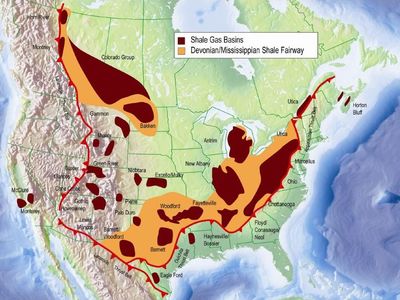 |
Shale Gas Plays of North America.
Courtesy of the National Energy Board, Canada |
| |
Calgary, Alberta, Canada - August 26, 2011
The Energy Resources Conservation Board (ERCB) has issued final approval to
Plains Midstream Canada (Plains) to resume operations of the NPS 20 Rainbow Pipeline.
The approval follows a comprehensive review and assessment, a third-party engineering review of the incident, and a number of conditions Plains was required to complete following the pipeline failure on April 28, 2011.
Plains is responsible for ensuring that the pipeline can be safely operated within all regulatory requirements.
In obtaining approval for the resumption of operations,
Plains has confirmed it has met the following conditions:
• Completion of work, to readiness for backfill, of all excavated sites inspected as per ERCB’s direction of May 17, 2011 (five priority sites and five additional sites);
• Implementation of weekly aerial surveillance of the pipeline to monitor for geotechnical hazards;
• Improved procedures and operations to ensure effective response should another failure occur; and
• Implementation of a Community Consultation Plan submitted to the ERCB on May 12, 2011, which includes meetings with local stakeholders prior to resumption of operations.
In addition, following the resumption of operations, the
ERCB requires Plains to submit monthly progress reports and attend monthly meetings with
ERCB personnel to ensure effective implementation of conditions of approval and regulatory requirements.
The engineering assessments concluded that the April 28, 2011 failure was due to high- stress on an existing crack in a fillet weld that was made on a weld-on sleeve.
Plains has committed to excavating and inspecting all sections of the pipeline containing these types of weld-on sleeves on an expedited schedule.
The interim maximum operating pressure of the pipeline has been limited to 5500 kPa, which is 75% of the pipeline’s maximum operating pressure.
The ERCB will actively monitor the resumption of operations of the Rainbow pipeline.
A start-up date has not been confirmed.
The ERCB continues its official investigation into the incident and will issue a full report at a later date.
For more information contact:
Darin Barter
ERCB Communications
403-681-0946
Darin.Barter@ercb.ca
Source: ERCB
http://www.ercb.ca/portal/server.pt?
Shale Gas
Shale is one of the most common sedimentary rocks in the world and it is primarily composed of clay and fragments of other minerals such as quartz and calcite.
Shale can be the source, reservoir and the seal for natural gas.
 |
The Honourable Ronald Liepert, Minister of Energy.
Courtesy of the Government of Alberta, Canada. |
| |
Shale formations normally have low permeability (limited ability for gas or fluids to flow easily through the shale formation) and normally require stimulation techniques (such as fracturing) to economically produce shale gas.
Shale gas is natural gas that is attached to, or "adsorbed" onto, organic matter or is contained in thin, porous silt or sand beds interbedded in the shale.
Shale gas is unconventional gas
Shale gas is considered an unconventional source as the gas is contained in difficult-to-produce reservoirs, which require special completion, stimulation and/or production techniques to achieve economic production.
Industry is interested in developing Alberta’s shale gas
As conventional gas plays in Alberta continue to mature, industry is looking towards other potential gas sources for development.
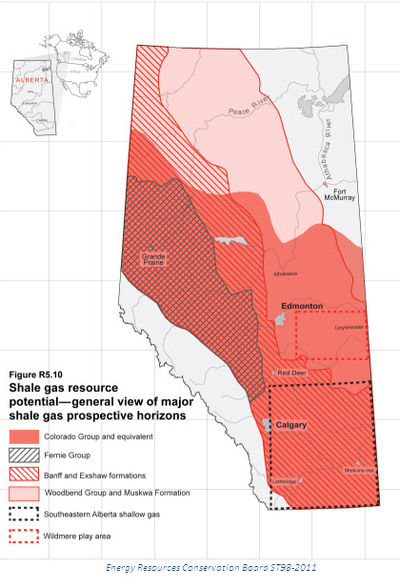 |
Shale gas resource potential – general view of major shale gas prospective horizons.
Courtesy of the Government of Alberta, Canada. |
| |
Shale has the potential to make a significant contribution to Alberta’s future natural gas supply as advancements in drilling and completion technologies allow the economic development of some shale gas resources.
Alberta’s shale gas and where it is found
The Alberta Geological Survey (AGS) has identified about 15 prospective shale gas formations.
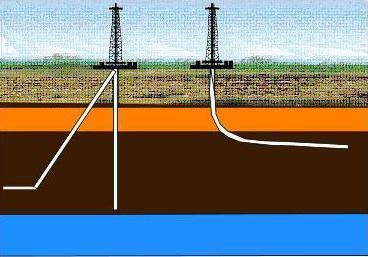 |
Thermogenic shale gas, normally formed during deep burial where heat and pressure cook the organic matter releasing natural gas, is often developed using horizontal drilling and multi-stage hydraulic fracturing.
Courtesy of the Government of Alberta, Canada. |
| |
The Gas Technology Institute estimates Alberta has approximately 850 trillion cubic feet (Tcf) of shale gas in place.
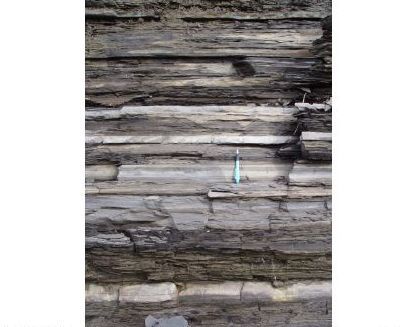 |
Utica Shale near town of Donnaconna, Quebec, Canada.
Dark beds are shale, light beds are limestone. Part of the dark colour in the Utica Shale comes from organic matter. A writing pen is shown for scale.
Courtesy of the National Energy Board, Canada.
|
| |
Given its very early stages of development in Alberta, it is not yet known what portion of these resources can be economically produced.
 |
Biogenic (Nursery) and Thermogenic (Kitchen) Methane Generation.
Courtesy of the National Energy Board, Canada.
|
| |
The ERCB is currently evaluating the shale gas resource potential of all prospective shale gas formations in Alberta.
Shale gas production
The same techniques used for conventional shallow gas development may also be used with shale gas drilling.
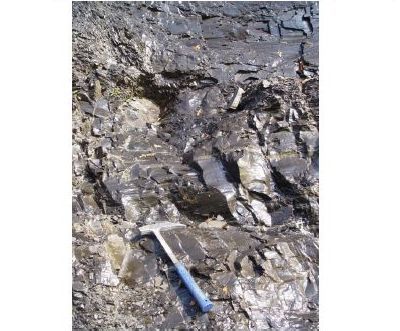 |
Heavily Fractured Utica Shale near fault, Montmorency Falls, Quebec, Canada.
Courtesy of the National Energy Board, Canada. |
| |
However, due to the low permeability that is characteristic of
shale formations, stimulation techniques such as horizontal drilling and
multi-stage hydraulic fracturing are often required to achieve economic production.
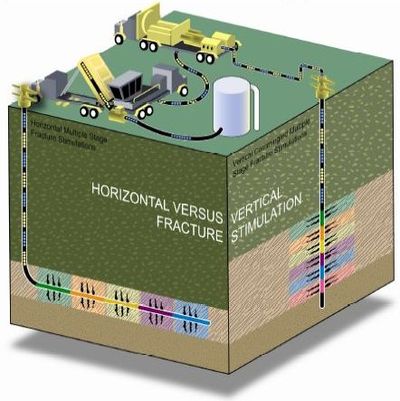 |
Horizontal Versus Vertical Wells and Multi-stage Hydraulic Fracturing.
Courtesy of the National Energy Board, Canada. |
| |
However,
shale gas can be produced from vertical and directional wells.
The majority of Alberta’s production is achieved using vertical wells along with a few horizontal wells.
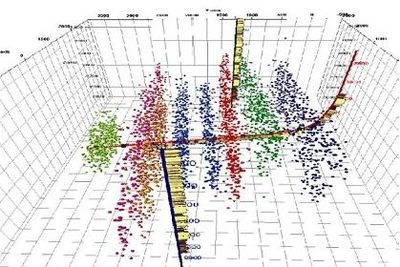 |
Microseismic Imaging of a Multi-stage Frac.
Courtesy of the National Energy Board, Canada. |
| |
Vertical and directional shale wells are commonly commingled with other production zones to yield economic production.
In recent years, improvements in the use of
horizontal drilling combined with
multi-stage fracturing have resulted in some shale gas formations becoming some of the
most attractive natural gas resources in North America.
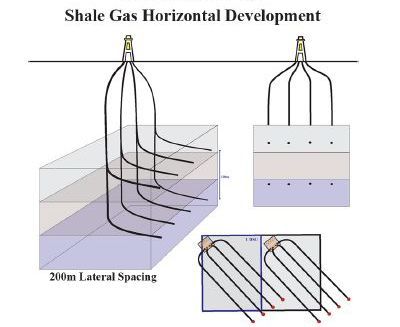 |
Schematic of a multi-well drilling pad and multiple horizontal wells originating from the same wellsite.
Courtesy of the National Energy Board, Canada.
|
| |
Shale gas development in Alberta is still in its early stages.
The number of connections producing shale gas in
Alberta (each well bore can have more than one connection) has only increased
from 5 connections in 2000 to 142 connections in 2010.
Determining the number of wells per section
Shale gas can be developed using various drilling and completion methods depending on the reservoir’s characteristics but generally, due to its low permeability,
8 to 16 subsurface drainage wells per section are required to effectively recover the underground gas in a shale play.
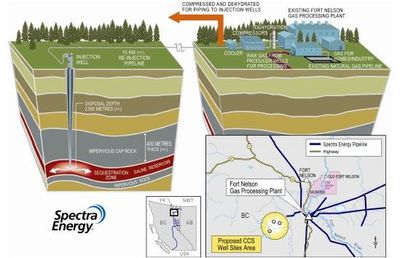 |
|
Schematic of Spectra Energy’s proposed carbon dioxide sequestration facility near Fort Nelson.
Courtesy of the National Energy Board, Canada. |
| |
Thermogenic shale gas, normally formed during deep burial where heat and pressure cook the organic matter releasing
natural gas, is often developed using
horizontal drilling and
multi-stage hydraulic fracturing.
These techniques can be combined with multi-well pad drilling to reduce the number of well sites per section that are needed.
The production from one horizontal wellbore with 10 fracture stages may in some cases be equivalent to drilling 10 vertical wells with a single fracture each.
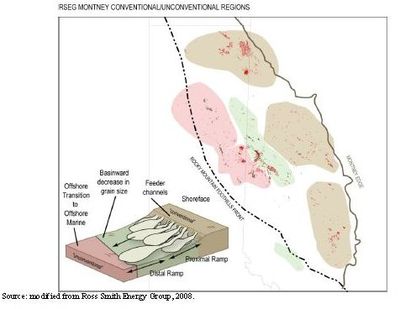 |
Montney Formation Gas Production and Play Types in Northwestern Alberta and Northeast British Columbia, Canada.
Courtesy of the National Energy Board, Canada. |
| |
As of
July 2011, shale gas production in Alberta has not used the horizontal drilling with multi-stage fracturing methodology commonly used in other jurisdictions.
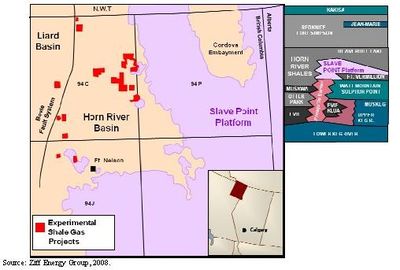 |
Horn River Basin Stratigraphy and Location.
Courtesy of the National Energy Board, Canada. |
| |
Instead,
shale gas development in Alberta has occurred primarily through the use of vertical wells as well as a few horizontal wells.
The Alberta Energy Resources Conservation Board (ERCB) regulates well spacing.
Regulating shale gas development in Alberta
Alberta has extensive experience in the development of energy resources and has a strong regulatory framework already in place.
Shale gas is currently regulated under the same legislation, rules and policies as conventional natural gas.
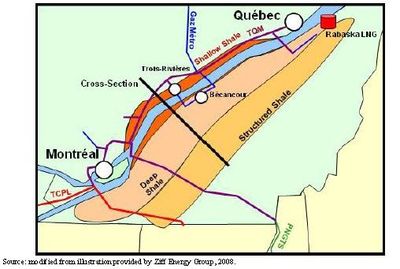 |
The Utica Shale and Location of Potential Production Trends.
Courtesy of the National Energy Board, Canada. |
| |
Although
shale gas development in Alberta has not been using horizontal multi-stage fracturing, Alberta does have extensive experience with hydraulic fracturing.
Approximately 167,000 wells have been hydraulically fractured in Alberta since the technology was introduced more than 50 years ago.
Most aspects of the oil and gas industry are regulated in Alberta by the Energy Resources Conservation Board.
The Board sets requirements for drilling and production operations.
The ERCB protects our fresh water aquifers (groundwater) with strict regulations that are designed to ensure that gas cannot migrate up a well bore to contaminate groundwater sources.
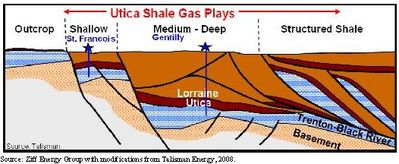 |
Northwest to Southeast Cross-section of the Utica Shale.
Courtesy of the National Energy Board, Canada. |
| |
Well bores are required to have cemented casings in place that meet stringent requirements and which are also set to depths far below any fresh water aquifers.
This ensures there is an impenetrable barrier between the shale gas formation and the well bore so that gas and fluids are unable to use the well bore as a pathway to contaminate groundwater.
Alberta has strict requirements in place to manage the safe disposal of produced fluids (fluids that return to the well head as part of the hydraulic fracturing process) and does not allow produced fluids to be sent to municipal waste water treatment systems.
Fluids that cannot be treated and recycled must be disposed of in approved disposal wells where the fluids are injected deep underground for permanent disposal.
The ERCB has not documented any cases of groundwater being contaminated as a result of hydraulic fracturing.
Government Links:
Alberta Environment www.environment.alberta.ca/
Alberta Geological Survey www.ags.gov.ab.ca/
National Energy Board www.neb-one.gc.ca/
Source: Government of Alberta
http://www.energy.alberta.ca/NaturalGas/944.asp
ASTROMAN magazine

